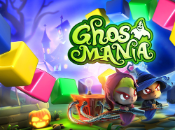Ghost Mania Review
|
|
See PixlBit's Review Policies

On 01/17/2011 at 06:56 PM by Jason Ross I ain't afraid of no ghost. |

Only for those who like block-based puzzle solving. The other game modes are too random and remove too much control for much fun or enjoyment, even at the game's low price.
Haunted houses, ancient pyramids, desert plains. While playing the block puzzler Ghost Mania, I watched all of these in the background as I dropped blocks down to shake ghosts out of haunted colorful blocks.

What is Ghost Mania? For those familiar with several puzzle games, it's something like Puyo Pop meets Puzzle League with the meanest random-number generator from Tetris. Players drop blocks from a line six-blocks wide on the top of the screen. The goal? Connect as many blocks of a single color together, then clear all the connected blocks with a magical sparkly ghost-busting block of the same color. The larger the number of blocks cleared, the higher the score. Through resourceful engineering and luck, it's possible to clear more than one color at once for a chain bonus or drop two clearing blocks at once for a double bonus. In most modes, as the player clears blocks, new levels raise from the bottom of the screen, applying a degree of pressure, forcing puzzlers to work quickly to avoid losing.
For some reason, clearing blocks traps ghosts for Ghost Mania's two protagonists, the moody, but lazy Tim and Becky who accidentally let all the ghosts away by sleeping on the clock. Tim seems to blame Becky for all his problems, and likewise, Becky blames Tim. The pair is drawn on screen to look somewhat similar to clay models, akin to James and the Giant Peach, though as they're entirely inanimate on screen, the artistic effect is severely reduced. As mentioned above, there are several locales to “wallpaper” the stages with. As players progress in the Arcade and Puzzle modes, they move from location to location, though the gameplay doesn't change one bit based on the background. For a Red-Green colorblind gamer like myself, the red and green blocks were varied enough that I didn't have much trouble distinguishing them (though yellow and green were a bit close for my liking, they weren't a problem, either,) so the colors present didn't seem to be an issue in the game.

A few elements of block-clearing don't mix well in Ghost Mania. First, the blocks that appear at the top of the screen to drop onto the board appear at random. Imagine having a hoard of blue blocks. In most puzzle games with colored blocks, that sounds like paradise or nirvana. In Ghost Mania, it's of no value because clearing the pile of blue blocks requires a blue, shiny ghost-block. The result is luck-based gameplay, where success depends entirely on the frequency and color of clearing blocks. Frustratingly, like in Tetris, the right pieces never fall at the right time. Unlike Tetris, other pieces can't be used to substitute for “the right piece,” and the board is much, much smaller, so stalling isn't a viable option. Worse, it's impossible to level the blocks placed onto the playing field. One tall pillar of blocks can't be spread out, further reducing any ability to stall for time in either the arcade or endless mode.
I've mentioned a few different gameplay modes already, and in Ghost Mania, there are three: Arcade, Endless, and Puzzle. Arcade and Endless are very similar. In Arcade, the player is meant clear blocks until reaching a designated score. A subsequent stage is unlocked upon reaching said score, and the process begins again on a clean game board. On Endless, the game only ends when one pillar of blocks reaches the top of the screen. In this sense, Arcade feels rather pointless, since players can play the never-ending mode to get their block-puzzle fix until contented. Even stranger and more pointless, combos, chains, and block clears are worth a fraction of the value assigned in Endless, making all methods of scoring less effective in the arcade mode for no apparent reason.

The game's sole redeeming factor is the Puzzle option. In puzzle mode, players are given a limited number of turns with specific blocks waiting to be dropped in each stage. There are about 40 puzzle stages, accessible one at a time. Unfortunately, the puzzle mode doesn't seem to be fully developed. While a great addition, it's possible to clear some boards leaving blocks available to be dropped, blocks that feel as they exist to make some puzzles more difficult. Still, the puzzle mode remains the most straight-forward, solid experience in the game.
In addition to the three main modes, head-to-head two-player modes are available. Essentially multiplayer versions of the main game modes, one mode is endless until someone loses, dumping cleared blocks onto the other player's board. The next has players compete to reach a certain score. The last requires clearing the board before one's opponent. Since players don't receive the same block patterns, these modes can come up to luck, rather than skill, as well.
Ghost Mania is a 500 Wii Point game. It's not a great one, as two of its three modes are mostly controlled by chance. The board is pretty tiny, and there's a definite lack of control over the blocks in the game. The puzzle mode is a nice diversion, but can be completed in an hour or two, at best. Ghost Mania simply isn't worth the money, even at its value price.










Comments